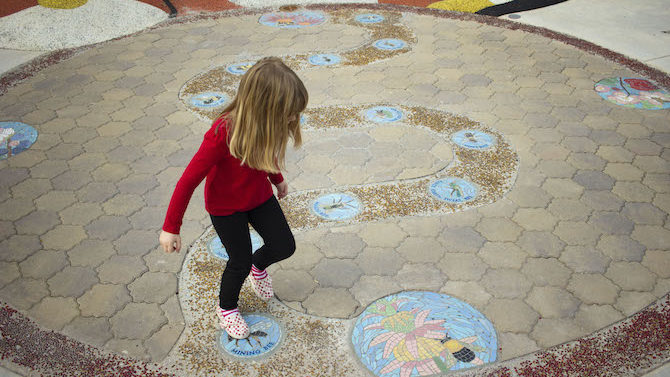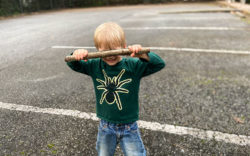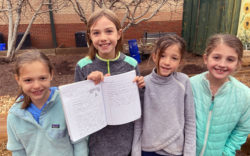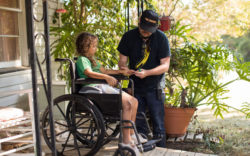It’s spring, and this weekend, we’re all going to have a really good reason to go outside.
That’s because the new Alice H. Richards Children’s Garden at the State Botanical Garden of Georgia is going to be open, and judging by a tour that was given to members of the local media in late November, it’s going to be one of the most magical playgrounds in the Athens area—or, across the state, even.
At the time, it still looked like a construction zone. It was missing a rambling metal sculpture that serves as the entryway, as well as a “discovery wall” that now meets you as you enter, to help explain the various parts of the garden and how they represent the state. But I’ll be honest, it was hard to contain my excitement as I toured with Josh Koons of Koons Environmental Design, the lead designers on the project.
The official University of Georgia-sanctioned opening takes place Saturday, Mar. 23 from 9 a.m.–4 p.m. Here’s a quick rundown of some of the highlights:
Georgia’s Geography: The most visible portion of the garden, which is located in a hard-to-miss spot across the driveway from the botanical garden’s visitor’s center, tells the story of Georgia’s landscapes and fauna through its features. Water features flow from the “mountains”—central elevated areas—through the “piedmont” and into flatter “coastal” areas. Kids can play in small waterfalls or inspect a collection of pitcher plants in a “swampy” section. (No, it’s not really a swamp—just a gardener’s interpretation of one.) There are also chunks of granite, caves and fossils waiting to be discovered under sand.
Unstructured Play: Yes, it has a slide and places where kids can climb like a more traditional playground. But these are few, and well worked into the overall design. This playground is more about learning and discovery than sliding and swinging. In the granite section, for example, kids can dip their hands into fresh water and “draw” with their wet fingers on the rock. Or they can duck into a cave and look at the roots of the plants growing on the other side. There is also a dedicated vegetable garden space, where the garden’s curator will be growing things throughout the year and encouraging kids to get their hands dirty. Plans in another area called for a sandbox, but when a donor to the botanical garden gave a collection of fossils, they found a use for them installed under the sand, where kids can dig and discover.
Pinterest-worthy: As you go through the garden, keep your eyes peeled for little touches that are unique to this space—and are worthy of your garden board on Pinterest or Instagram account. For example, a fence near the granite is made from repurposed oversized drill bits that once cut the large rocks. The vegetable garden sits in large metal beds, and sculptural shades will keep them from getting too hot in the summer. When you sit under a trellis, look up and check out the marbles embedded in the wood above. Koons said he and his team liked the idea of sitting down and noticing little dots of color around you. Even the trellises themselves, built with a scattered design rather than a typical uniform pattern, create the feel of a rambling garden space.
And, of course, there are the mosaics. Athens artist Krysia Ara has been working on the pieces for months, and they are gorgeous, scientifically accurate representations of Georgia’s native plants and insects. They can be found inset along walls and in pathways, adding color to what could have been just gray stone. The “pollinator pathway,” for example, features custom circular mosaics of Georgia’s many bee species, set off with glass beads embedded in the surrounding concrete. Children at the botanical garden’s summer camps, as well as adult volunteers and guests throughout the year, helped glaze the pieces, which adds a community connection to the mosaics.
Natural Setting: Second to the mosaics, what also took my breath away was a secondary section of the children’s garden that leads to a less sculpted area. Walk through a ribcage of wooden beams, or, as Koons describes it, the imaginary shape of a giant chestnut that has fallen to the ground. The curved pieces lead you through an open tunnel of sorts down a gently sloping hill and another play area. This one has a treehouse and other natural play places—perfect for games, climbing and just escaping into the woods. If you looked at the area from above, the pathway would resemble a tree, with its branches leading to new places to play. It’s something I’ve been looking for in a playground for years, but never found: that mixture of natural and man-made, where the organic elements can really shine. There are no plastic slides or metal stairs. Here, you navigate the natural world in your own imaginary way.
Honestly, there’s even more that I don’t have room for in this space—a “Monet bridge,” another bridge that will wobble on the water as you walk on it, a lookout tower, Ara’s ladybug sculpture, teacup-like flowers kids can sit in and a pavilion for educational activities (and, hopefully, birthday parties?) that has its own unique design. Heck, even the bathrooms, all wood with custom elements from local woodworkers, are worth a mention.
The botanical garden’s director, Jennifer Cruse-Sanders, said she expects an additional 50,000 guests as a result of the new children’s garden. I know I’ll be one of them.
Like what you just read? Support Flagpole by making a donation today. Every dollar you give helps fund our ongoing mission to provide Athens with quality, independent journalism.










